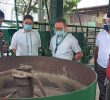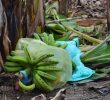By Germelina A. Lacorte
Davao Today
DAVAO CITY�A strange fish circled its way around the narrow confines of an aquarium that attracted crowds around the Vitarich booth in a recent Mindanao investment forum here. It had the head of a catfish, which reminds Mindanao growers of the local �hito,� but with the flat body of most saltwater fish. According to the posters that Vitarich posted on the wall, this catfish can grow as big as a shark.
It was the Mekong catfish�also called as pangasius here�which used to grow only in the great Mekong river that coursed through Vietnam, Laos and Thailand.
But the crowd, which included three chefs from Marco Polo hotel, was not there only for curiosity sake.
Business and trade officials have been promoting the fish for its high �export potential,� enticing fish growers and exporters in Mindanao to grow this fish at home. A prime export of Vietnam, the Mekong catfish has enjoyed a high demand in Europe, notably in Russia and Poland; and in the US and Australia.

Mekong catfish, popularly known in Davao as “pangasius,” is a fish that naturally grows from the Mekong river delta. Thinking of the local “hito,” Mindanao fish growers easily relates to it. (davaotoday.com photo)
According to the market data gathered by Vitarich, exports of Mekong fish in 2006 reached as high as US$750 million.
�It can be a lucrative option for tilapia and bangus farmers in Mindanao,� said Eduardo Lazo, business development manager of Vitarich Corporation, which is contract growing the fish in Luzon. He said the fish enjoys brisk demand, not only in the world market, but also among high end restaurants and hotels in the country.
�Right now, we�re still importing it and the biggest importers include high end restaurants in Mindanao,� he said. In fact, the three chefs were viewing it because they�ve been doing its recipe for quite a time but they�ve seen the fish only for the first time.
Lazo said that the Philippines has been importing Mekong catfish since late 2005.
Scientifically known as “pangasius hypopthalmus� or �pangasius pangasidae,� Mekong catfish is an air-breathing fish that can survive even in poor quality water. Among its market name abroad are “white roughly,” “Royal Basa,” “Mekong catfish,” “pangasius catfish” while its local names include the Mekong Kanduli, Kanduhito, Pangasius. Sometimes, its pet name include, “iridescent shark,” “hammer head, siamese shark. It�s also known as �pa suay kheo” in Laos.

Mekong catfish, popularly known in Davao as “pangasius,” is a fish that naturally grows from the Mekong river delta. Thinking of the local “hito,” Mindanao fish growers easily relates to it. (davaotoday.com photo)
Dorecita Delima, assistant regional director of the Department of Trade and Industry (DTI), urged local fish exporters, especially those in General Santos and Sarangani, to maximize their farm area to raise this kind of fish.
Although the fish is only found in the great Mekong river growers believe it can easily adapt to local condition in Mindanao.
Delima said that the deteriorating quality of Vietnam may enable the Philippines to enter into the market, if local producers can figure out ways to cut down production cost. She said the cost of feed make up 70 per cent of its production cost but local growers are looking for cheap raw material substitutes that might bring down cost.
According to Lazo, there is a big potential for the local product to beat Vietnam exports. �Other Asian suppliers have spotty track record and poor image in the US,� Lazo said in his presentation, �Pangasius, the Love Fish.� Vitarich has been running a hatchery in Pampanga, and contracting the fish to fishgrowers in Luzon. Lazo said that Vitarich supplies pangasius fish fillet and other processed fish products to high end restaurants in the country. He said the imported fish is already beginning to appear in some wet markets in the country.

Mekong catfish, popularly known in Davao as “pangasius,” is a fish that naturally grows from the Mekong river delta. Thinking of the local “hito,” Mindanao fish growers easily relates to it. (davaotoday.com photo)
Delima said that some fish growers have already began switching into it. �Some growers think of our own �hito,� and feel they can raise it here in Mindanao,� she said.
�It�s a fast growing fish that can be harvested in only six months and can easily be grown even in murky waters,� said Delima. (Germelina Lacorte/Davao Today)
Food, mekong fish









